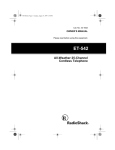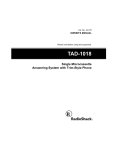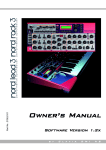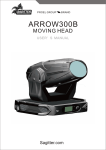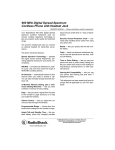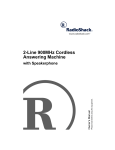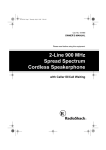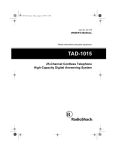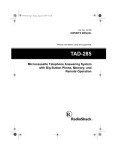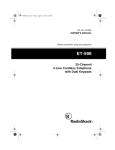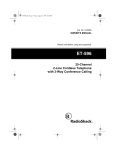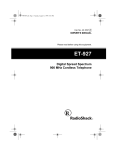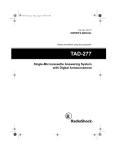Download Radio Shack 43-141 Owner`s manual
Transcript
43-738.fm Page 1 Friday, August 13, 1999 1:51 PM Cat. No. 43-738 OWNER’S MANUAL Please read before using this equipment. TAD-268 25-Channel 10-Memory Cordless Telephone Answering System with Two-Way Paging andemory25Intercom 43-738.fm Page 2 Friday, August 13, 1999 1:51 PM Warning: To reduce the risk of fire or shock hazard, do not expose this product to rain or moisture. CAUTION RISK OF ELECTRIC SHOCK. DO NOT OPEN. ! CAUTION: TO REDUCE THE RISK OF ELECTRIC SHOCK, DO NOT REMOVE COVER OR BACK. NO USER-SERVICEABLE PARTS INSIDE. REFER SERVICING TO QUALIFIED PERSONNEL. This symbol is intended to alert you to the presence of uninsulated dangerous voltage within the product’s enclosure that might be of sufficient magnitude to constitute a risk of electric shock. Do not open the product’s case. ! This symbol is intended to inform you that important operating and maintenance instructions are included in the literature accompanying this product. READ THIS BEFORE INSTALLATION We have designed your telephone to conform to federal regulations, and you can connect it to most telephone lines. However, each device that you connect to the phone line draws power from the phone line. We refer to this power draw as the device’s ringer equivalence number, or REN. The REN is shown on the bottom of the base. If you are using more than one phone or other device on the line, add up all the RENs. If the total is more than five, your phone might not ring and your TAD might not answer. In rural areas, a total REN of three might impair ringer operation. If ringer operation is impaired, disconnect one of the devices from the line. FCC STATEMENT Your TAD complies with Part 68 of FCC Rules. You must, upon request, provide the FCC registration number and the REN to your phone company. Both numbers are shown on the bottom of the base. Note: You must not connect your TAD to any of the following: • Coin-operated systems • Party-line systems • Most electronic key phone systems © 1997 Tandy Corporation. All Rights Reserved. Radio Shack is a registered trademark used by Tandy Corporation. 2 43-738.fm Page 3 Friday, August 13, 1999 1:51 PM FEATURES Your Radio Shack TAD-268 25-Channel 10-Memory Cordless Telephone Answering System with Two-Way Paging and Intercom is perfect for your home or office. The built-in answering machine’s features make it easier for you to record and respond to calls. You can even program it so it calls you at another phone or pager number when it receives an incoming call. The telephone works with the answering machine’s features for easy, hasslefree operation. The handset allows portable cordless operation both during a call and while you program the TAD. TELEPHONE FEATURES Super CCT Noise-Reduction Circuitry — provides clear telephone conversations, giving you sound comparable to that of a corded phone. Intercom System — lets you talk with someone at the handset or the base, or locate the handset if you misplace it. Redial — lets you dial the last number dialed by pressing a single button. Flash — sends an electronic switchhook signal for use with special phone services such as call waiting. Hold Button — lets you put a caller on hold. Charge Indicator — blinks when it is time to recharge the handset’s battery. Touch Tone or Pulse (Rotary) Dialing — lets you use your phone with either type of service. Hearing-Aid Compatibility — lets you use your phone with hearing aids that have a T (telephone) switch. 25 Channels — the phone helps you select a clear channel to use between the base and the handset. 10-Number Memory — lets you quickly store and then dial important phone numbers. Security Access-Protection Code — helps prevent other cordless phone users from using your phone line. Three Adjustable Volume Controls — let you control the volume of the sound you hear through the base and handset receiver, and from the handset ringer. 3 43-738.fm Page 4 Friday, August 13, 1999 1:51 PM TAD FEATURES Auto-Call — you can set the phone to call a designated phone or pager number when someone leaves a message, so you know when to retrieve messages while you’re away from the phone. Digital Outgoing Announcement — records your outgoing announcement into the TAD’s digital memory, then plays it from the memory when the TAD answers calls. Outgoing Announcement Backup — saves your outgoing announcement on the supplied microcassette tape, so it can restore the announcement to the TAD’s digital memory after a power failure. Call Screening — lets you listen as a caller leaves a message so you can decide whether or not to answer the call. Remote Answer-On — lets you use a remote phone to set the TAD to answer calls. Toll-Saver — answers after only two rings when you have messages; otherwise, the TAD answers after four rings. This lets you hang up before the TAD answers to avoid a toll charge. Remote Operation Security Code — lets you set, use, and change a 4-digit number. This helps prevent unauthorized access by callers to incoming messages. Adjustable Incoming and Outgoing Message Length — lets you set the incoming message length to 3 minutes or 30 seconds, and record an outgoing message of up to 21 seconds. Announce Only Mode — lets you set the TAD to play an announcement without recording caller’s messages. VOX — stops recording after several seconds of silence to help conserve tape space. Please read this manual completely before you use your TAD-268. It explains how to use the TAD’s features. Memo Recording — lets you leave reminders for yourself or messages for others in your home or office. For your records, we urge you to record your telephone’s serial number in the space below. The serial number is located on the bottom panel of the base. Two-Way Conversation Recording — provides a convenient way to record both sides of a conversation. Remote Operation — lets you retrieve your messages from any touch-tone phone or from any rotary phone using a pocket tone dialer. 4 Serial Number: __________________ This telephone has been tested and found to comply with all applicable UL and FCC standards. 43-738.fm Page 5 Friday, August 13, 1999 1:51 PM Note: Your phone operates on standard radio frequencies, as allocated by the FCC. Therefore, it is possible for other radio units operating on similar frequencies, within a certain area, to inadvertently intercept your conversations and/or cause interference on your cordless telephone. This lack of privacy can occur with any cordless phone. Important: Cordless phones such as this one require AC power to operate. When the AC power is off, you cannot dial out or receive incoming calls using your TAD-268. For this reason, the TAD-268 should not be your only telephone. To be safe, you should also have a phone that does not require AC power to operate (not a cordless phone) so you can still make and receive calls if there is an AC power failure. 5 43-738.fm Page 6 Friday, August 13, 1999 1:51 PM CONTENTS Installation ............................................................................................................ 8 Selecting a Location ........................................................................................ 8 Connecting the Battery .................................................................................... 8 Installing the Tape............................................................................................. 9 Connecting to Power ........................................................................................ 9 Charging the Battery ...................................................................................... 10 Connecting the Base to the Phone Line .......................................................... 11 Adjusting the Base’s Antenna......................................................................... 11 Using the Belt Clip ......................................................................................... 12 Telephone Preparation ...................................................................................... 13 Setting the Dialing Mode ............................................................................... 13 Setting the Volume ........................................................................................ 13 Using the Telephone ........................................................................................... Confirmation and Error Tones ........................................................................ Making/Answering a Call ................................................................................ Turning Quick Call Off .............................................................................. Changing Channels ........................................................................................ Using Flash .................................................................................................... Using Redial ................................................................................................... Using Tone Services on a Pulse Line ............................................................ Using Hold ...................................................................................................... Using the Intercom ........................................................................................ Memory Dialing .............................................................................................. Storing Phone Numbers in Memory ........................................................ Storing a Pause ...................................................................................... Dialing a Stored Number ......................................................................... Chain-Dialing from Memory .................................................................... Using an Optional Headset ............................................................................ 15 15 15 15 16 16 17 17 18 18 19 19 20 20 20 21 TAD Preparation .................................................................................................. Setting the CPC Switch ................................................................................. Recording an Outgoing Announcement ........................................................ Using the Base ........................................................................................ Using the Handset .................................................................................. Checking the Outgoing Announcement ......................................................... Using the Base ........................................................................................ Using the Handset .................................................................................. Setting the Maximum Incoming Message Length .......................................... Setting the Number of Rings/Toll Saver.......................................................... 22 22 22 23 24 24 24 24 25 25 6 43-738.fm Page 7 Friday, August 13, 1999 1:51 PM Using the TAD ..................................................................................................... 26 Setting the TAD to Answer Calls ................................................................... 26 Setting the TAD Not to Answer Calls ....................................................... 26 Setting the TAD to the Announce Only Mode ............................................... 26 Screening Calls .............................................................................................. 27 Playing Messages ......................................................................................... 28 TAD Function Chart......................................................................................... 29 Erasing Messages ........................................................................................ 31 Recording a Memo......................................................................................... 31 Using the Base ....................................................................................... 31 Using the Handset .................................................................................. 32 Recording a Two-Way Conversation ............................................................. 32 Auto Call ....................................................................................................... 33 Storing a Pager or Telephone Number ................................................... 33 Turning the Auto Call Function On/Off .................................................... 34 Remote Operation ............................................................................................. Storing Your Remote Operation Security Code ............................................ Remote Answer On........................................................................................ Accessing the TAD by Remote ..................................................................... Using Remote Control Commands ............................................................... 36 36 36 37 38 Troubleshooting ................................................................................................ 44 Care and Maintenance ...................................................................................... Replacing the Battery..................................................................................... Cleaning the Tape-Handling Parts ................................................................ The FCC Wants You to Know ........................................................................ Lightning ........................................................................................................ 47 48 49 50 50 7 43-738.fm Page 8 Friday, August 13, 1999 1:51 PM INSTALLATION Important: After you select a location for the phone (see “Selecting a Location”), you must install the phone in the following order before you use it for the first time. 1. Connect the battery to the handset (see “Connecting the Battery”). 2. Install the microcassette tape (see “Installing the Tape” on Page 9). 3. Connect the base to power (see “Connecting to Power” on Page 9). 4. Charge the phone’s battery (see “Charging the Battery” on Page 10). 5. Connect the base to your phone line (see “Connecting the Base to the Phone Line” on Page 11). SELECTING A LOCATION The base’s location affects the phone’s range. If you have a choice of several locations, try each to see which provides the best performance. Note: Your phone operates on frequencies that might cause interference to TVs or VCRs. To prevent or minimize such interference, avoid placing the base on top of or near a TV or VCR. If you notice interference, increase the distance between the base and the TV or VCR, or reorient or relocate the receiving antenna on the TV/ VCR. CONNECTING THE BATTERY Your TAD comes with a rechargeable nickel-cadmium battery installed. However, you must plug in the battery and charge it for about 24 hours before you use the phone for the first time. Select a location for the TAD that is: • Near an AC outlet • Near a modular phone line jack • Out of the way of normal activities • Away from electrical machinery, electrical appliances, and metal walls or filing cabinets • Away from wireless intercoms, alarms, and room monitors • Away from other cordless phones 8 Follow these steps to plug in the battery. 1. While pressing down and holding the battery compartment cover on the back of the handset, slide it down to open it. 43-738.fm Page 9 Friday, August 13, 1999 1:51 PM 2. Attach the connector on the battery to the connector inside the battery compartment. 3. Install the microcassette in cassette compartment with open edge of the cassette on left and the full reel toward front of the TAD. the the the the Notes: 3. Replace the battery compartment cover. After you connect the battery, you must set up the base then charge the battery. INSTALLING THE TAPE Follow these steps to install the supplied microcassette tape. 1. Turn the supplied microcassette’s hub with a pencil to take up any tape slack. • You can buy additional microcassettes or microcassettes of a different length at your local Radio Shack store. • Replace the tape at least once a year — more often if it is used heavily. CONNECTING TO POWER 1. Insert the AC adapter’s barrel plug into the DC IN 7.5V jack on the back of the base, then thread the supplied AC adapter’s cord through the strain relief slot under the base. Note: Use only the supplied AC adapter as your phone’s 7.5V DC 500 mA power source. 2. Lift up on the left side of the cassette compartment cover on top of the base to open it. 9 43-738.fm Page 10 Friday, August 13, 1999 1:51 PM 2. Plug the adapter into a standard AC outlet. The TAD positions the tape for operation, which takes up to 1 minute. Note: If there is no backup outgoing announcement on the message tape, the TAD beeps. If there is a backup outgoing announcement on the message tape, the TAD automatically restores the announcement from the tape into memory. See “Recording an Outgoing Announcement” on Page 22. CHARGING THE BATTERY You must charge the battery in the handset for at least 24 hours before you connect the phone to the phone line and use the phone for the first time. You can recharge the battery at any time, but be sure to recharge it when the CHARGE indicator on the handset flashes. 10 To charge or recharge the battery, place the handset on the cradle. The CHARGE indicator lights. Notes: • When you place the handset on the cradle, the system’s security access-protection code automatically activates. This prevents other cordless phones from using your telephone line. • If the CHARGE indicator does not stay lit when you place the handset on the cradle, be sure the AC adapter is properly connected. Also, check the charging contacts on the handset and base. If the contacts are dirty or tarnished, clean them with a pencil eraser. • A full charge lasts about 24 hours if you leave the handset off the base and do not make any calls. Be sure to return the handset to the base when you see the CHARGE indicator blinking. 43-738.fm Page 11 Friday, August 13, 1999 1:51 PM • About once a month, fully discharge the battery. Otherwise, the battery loses its ability to fully recharge. To fully discharge the battery, set RINGER on the side of the handset to LO or HI and keep the handset off the cradle until the CHARGE indicator starts to flash. Then return the handset to the cradle and fully recharge the battery. • For the best performance, you should replace the supplied battery (Cat. No. 23-192, available from your local Radio Shack store) about once a year — more often if it is used heavily. When the battery cannot fully recharge, replace it with a new one. See “Replacing the Battery’’ on Page 48. CONNECTING THE BASE TO THE PHONE LINE 1. Plug one end of the supplied modular cord into the TEL LINE jack on the back of the base. Notes: • If the phone line jack is not a modular jack, update the wiring. You can convert the wiring yourself, using jacks and adapters available at your local Radio Shack store. Or, you can let the phone company update the wiring for you. • The phone company will charge you for the installation of necessary jacks. • The USOC number of the jack to be installed is RJ11C. ADJUSTING THE BASE’S ANTENNA For the best reception, fully extend the base’s antenna and position it vertically. 2. Plug the other end of the cord into a modular phone line jack. 11 43-738.fm Page 12 Friday, August 13, 1999 1:51 PM USING THE BELT CLIP The supplied belt clip makes it easier to use the handset when you are on the go. Simply slide the belt clip over your belt or waistband. To attach the belt clip, press it onto the back of the handset as shown. To remove the belt clip, simply lift up on either side of the clip where it attaches to the handset. 12 43-738.fm Page 13 Friday, August 13, 1999 1:51 PM TELEPHONE PREPARATION Complete the procedures in this section before you use your telephone. SETTING THE VOLUME Your TAD has the following volume controls: SETTING THE DIALING MODE Set DIAL on the back of the base for the type of service you have — tone or pulse (rotary). If you are not sure which type you have, do this test. 1. Set DIAL to TONE. Base Volume: Set VOLUME on the back of the base to OFF, LO, or HI to adjust the message playback and intercom volume. Handset Receiver Volume: Set VOLUME on the side of the handset to LO or HI to control the volume you hear from the handset. 2. Lift the handset from the cradle, or press TALK on the handset, and listen for a dial tone. 3. Press any number other than 0. Note: If your phone system requires that you dial an access code (9, for example) before you dial an outside number, do not enter the access code either. Handset Ringer Volume: Set RINGER on the side of the handset to OFF, LO, or HI to control the handset’s ringer volume. If the dial tone stops, you have touchtone service. Leave DIAL set to TONE. If the dial tone continues, you have pulse service. Set DIAL to PULSE and return the handset to the cradle. 13 43-738.fm Page 14 Friday, August 13, 1999 1:51 PM Notes: • When RINGER on the handset is set to OFF and the handset is off the base, all the indicators on the handset turn off to save battery power. You can still make and answer calls even if RINGER on the handset is set to OFF. • When you receive a call and RINGER on the handset is set to OFF, the ringer does not sound and the TALK indicator does not blink on the handset. However, the IN USE indicator on the base blinks and other phones on the same line still ring. Simply press TALK on the handset or lift it from the cradle to answer the call (see “Making/Answering a Call” on Page 15). 14 43-738.fm Page 15 Friday, August 13, 1999 1:51 PM USING THE TELEPHONE Be sure you have completed the procedures in “Installation” on Page 8 and “Telephone Preparation” on Page 13 before you begin using the telephone. CONFIRMATION AND ERROR TONES When you press a button, the phone sounds a brief tone to indicate that it accepted the command. If three error tones sound, you pressed a button in error, you are out of range, the battery is low, or there is too much interference. Move the handset closer to the base and try again, or recharge the battery. MAKING/ANSWERING A CALL The quick call function automatically gives you a dial tone when you lift the handset from the cradle. (To turn off quick call, see “Turning Quick Call Off”). To make a call (with quick call on), simply pick up the handset from the cradle, or, if the handset is not on the cradle, press TALK on the handset until the TALK indicator on the handset lights. When you hear a dial tone, dial the phone number. To answer a call (with quick call on), pick up the handset from the cradle, or, if the handset is not on the cradle, press TALK on the handset. When you are finished with the call, hang up by either pressing TALK so the TALK indicator turns off, or return the handset to the cradle. Turning Quick Call Off The quick call function is preset to on at the factory, but you can turn it off. Follow these steps if you want to cancel this function so the phone does not give you a dial tone when you lift the handset from the cradle. 1. If the TALK indicator on the handset is on, press TALK to turn it off. 2. If the ANSWER or ANN ONLY indicator on the base is on, press ERASE/STOP to turn it off. 15 43-738.fm Page 16 Friday, August 13, 1999 1:51 PM 3. Press then MEMORY on the handset. The HOLD/INT indicator on the handset blinks and a long beep sounds. 4. Within 30 seconds, press FLASH then # on the handset. Note: If you do not press FLASH and # within 30 seconds, the HOLD/INT indicator on the handset turns off and the handset beeps twice. Repeat this procedure from Step 3. 5. Press MEMORY on the handset to store the new setting. The HOLD/ INT indicator turns off and a long beep sounds. To restore the quick call function, repeat Steps 1-5, but press instead of # in Step 4. CHANGING CHANNELS To reduce interference and get the clearest communications between the base and handset, you can change the channel the phone is using. The phone uses one of 25 channels when you hear a dial tone or during a call. When you press CHANNEL, the phone automatically changes to another channel and uses that one. Notes: • Since unwanted noise usually affects more than one consecutive channel, the phone does not tune to the next consecutive channel when you press CHANNEL. • Either the TALK or HOLD/INT indicator on the handset must be on to change the channel. • If the handset is too far from the base, the phone might not change channels. Move closer to the base and try again. USING FLASH Pressing FLASH sends the electronic equivalent of a switchhook signal. Use FLASH with special phone company services such as call waiting. If you have call waiting, you can press FLASH to take an incoming call without disconnecting the current call. Press FLASH again to return to the first call. 16 43-738.fm Page 17 Friday, August 13, 1999 1:51 PM distance as well as local phone numbers. • The redial memory also holds pause entries. See “Storing a Pause” on Page 20. Notes: • Do not press FLASH to hang up the phone. • The redial memory does not store a FLASH entry or any digits you pressed after FLASH. • If you do not have any special phone services, pressing FLASH might disconnect the current call. USING REDIAL To quickly redial the last number dialed, press PAUSE/REDIAL on the handset when you hear a dial tone. The phone automatically dials the last number dialed. • If you have pulse service, we recommend that you do not use the redial feature for numbers that include a tone change entry, because the one-second pause following the mode change might not be long enough to allow the special service to answer. See “Using Tone Services on a Pulse Line.” USING TONE SERVICES ON A PULSE LINE Some special services, such as bankby-phone, require tone signals. If you have pulse service, you can still use these special tone services by following these steps. 1. Be sure DIAL on the back of the base is set to PULSE. 2. Dial the service’s main number. 3. When the service answers, press TONE/# on the handset. Any additional numbers you dial now are sent as tone signals. Notes: • The redial memory holds up to 40 digits, so you can redial long- 4. After you complete the call, return the handset to the cradle or press TALK. The phone automatically resets to the pulse mode. 17 43-738.fm Page 18 Friday, August 13, 1999 1:51 PM USING HOLD USING THE INTERCOM Use the intercom feature when you want to talk with someone at the handset or the base. Follow these steps to call from the handset to the base. To put a caller on hold, press HOLD/INTERCOM on the handset so the TALK indicator blinks and the HOLD/INT indicator lights. To return to the call, press TALK. Notes: • If you pick up another phone connected to the same telephone line while a call is on hold, the TAD268 automatically releases the hold and you can talk with the caller. • After you put a call on hold, you can use the handset to talk to a person at the base using the intercom feature. See “Using the Intercom.” • If you do not release a call on hold within 5 minutes, the handset beeps for 1 minute, then the phone automatically hangs up. 18 1. Press HOLD/INTERCOM on the handset. The base rings three times, then the base’s speaker and microphone automatically turn on. You can talk with someone at the base. 2. When you complete your conversation, press HOLD/INTERCOM on the handset again, or the person at the base can press INTERCOM. Follow these steps to call from the base to the handset. 1. Press INTERCOM on the base. The handset rings. (This is handy for locating the handset when it is away from the base.) 2. When the person at the handset presses HOLD/INTERCOM, you can talk with them. 3. When you complete the conversation, either press INTERCOM on the base again, or the person at the handset can press HOLD/ INTERCOM. 43-738.fm Page 19 Friday, August 13, 1999 1:51 PM Notes: • If a call arrives while you are using the intercom, the handset sounds a tone. • The phone might not activate the intercom for about 2 seconds after the last time you use it. MEMORY DIALING You can store up to 10 different phone numbers of up to 16 digits each so you can dial them quickly. Storing Phone Numbers in Memory 1. Be sure DIAL is set for the type of service you have. 2. If the TALK indicator is on, press TALK on the handset to turn it off. Then, if the ANSWER or ANN ONLY indicator is on, press ERASE/STOP on the base to turn it off. 4. Using the number keys, enter the number of the memory location (09) where you want to store the phone number. 5. Enter the phone number you want to store, including any PAUSE/ REDIAL and TONE/# entries. (See “Storing a Pause” on Page 20 and “Using Tone Services on a Pulse Line” on Page 17.) Notes: • Each PAUSE/REDIAL or TONE/# entry uses one digit of memory. • If you have pulse service and want to store a number, we recommend that you do not store a number that includes a TONE/# entry. The one-second pause following the mode change might not be long enough to allow the special service to answer. See “Using Tone Services on a Pulse Line” on Page 17. 6. Press MEMORY to store the number into the selected location. A long beep sounds and the HOLD/ INT indicator turns off. 7. To store more numbers, repeat Steps 3-6. Notes: 3. Press #, then MEMORY. The HOLD/INT indicator starts to blink and a beep sounds. • If you receive a call while you store a number in memory, press TALK to answer the call. After the call, begin again at Step 2 to store the number. 19 43-738.fm Page 20 Friday, August 13, 1999 1:51 PM • To change a number you already stored, store a new one in its place. • To delete a number from memory, repeat Steps 2-6, but do not enter a phone number in Step 5. Storing a Pause In some telephone systems, you must dial an access code (9, for example) and wait for a second dial tone before you can dial an outside number. You can store the access code with the phone number. However, you must also store a pause after the access code to allow the outside line time to connect. To do so, press PAUSE/REDIAL at the appropriate place to enter a 2-second pause. For a longer pause, press PAUSE/REDIAL additional times. Chain-Dialing from Memory When you use special services such as alternate long-distance or bank-byphone, you can store the service’s phone number in one memory location, and any other numbers, such as the long-distance number, in another location. This lets you easily dial a long sequence of numbers. Follow these steps to chain-dial memory numbers. 1. Press MEMORY, then use the number keys to enter the memory location code for the service’s main number. 2. Wait for the service to answer. 3. Press MEMORY, then enter the memory location code for any remaining numbers. Notes: Dialing a Stored Number 1. Lift the handset from the cradle or press TALK and listen for a dial tone. 2. When you hear a dial tone, press MEMORY, then use the number keys to enter the memory location code (0-9). Important: When you test a stored number of an emergency service, make the test call in the off-peak hours, such as late evening or early morning, and remain on the line to explain the reason for your call. 20 • If you use pulse dialing to dial the service, after the service answers, press TONE/# before you enter memory location codes, or save TONE/# as the first entry in a stored number. • If you move from an area that uses pulse dialing to an area that uses tone dialing, you no longer have to press TONE/# to change the dialing mode. Therefore, if you previously stored any phone numbers into memory that included TONE/# entries, you must re-enter them. 43-738.fm Page 21 Friday, August 13, 1999 1:51 PM USING AN OPTIONAL HEADSET A jack on top of the handset lets you connect an optional headset (CMC No. 43-731, available from your local Radio Shack store) so you can conduct “hands-free’’ conversations. Follow these steps to use an optional headset. 1. Place the headset on your head. To wear the headset on your right ear, turn the receiver over clockwise. 2. Adjust the headset so the receiver is next to your ear and the microphone is close to your mouth. 3. Connect the headset’s plug to the jack on top of the handset. 21 43-738.fm Page 22 Friday, August 13, 1999 1:51 PM TAD PREPARATION SETTING THE CPC SWITCH nouncement can be up to 21 seconds long. You can also set the TAD so it plays an announcement but does not record a message. See “Setting the TAD to the Announce Only Mode” on Page 26. CPC (Calling Party Control) on the back of the base is set to MAX at the factory. If your TAD often records tele- phone company messages, dial tones, and so on, set CPC to MIN. Note: Call waiting, a service offered by most telephone companies, uses signals identical to CPC signals. If you have this service, you should leave CPC set to MAX. Otherwise, if the answering machine receives a second call while the first caller is leaving a message, the answering machine might hang up during the first caller’s message. RECORDING AN OUTGOING ANNOUNCEMENT Before you can use the TAD, you must record the outgoing announcement that the caller hears when the TAD answers a call. You can record the outgoing announcement from either the base or the handset, and your an- 22 Important: To help protect your home or office from theft, we recommend you do not tell callers that you are away. Instead, say that you cannot come to the phone. Notes: • When you record an outgoing announcement, you should ask for the caller’s name, phone number, and a message. • When you set the TAD to the announce only mode, we recommend you make it clear in the announcement that the caller cannot leave a message. • When you record an outgoing announcement, the TAD records a backup copy of it on the incoming message tape. When power is restored after a power failure, the TAD automatically retrieves the outgoing announcement from the message tape and re-records it into digital memory. 43-738.fm Page 23 Friday, August 13, 1999 1:51 PM Using the Base Follow these steps to record the outgoing announcement from the base. 1. If the TALK indicator is on, press TALK on the handset to turn it off. Then, if the ANSWER or ANN ONLY indicator is on, press ERASE/STOP on the base to turn it off. 2. Open the cassette deck compartment on top of the base, then press and hold down ANNOUNCE RECORD inside the compartment for about 1 second. You hear beeps while the TAD rewinds the tape for the announcement backup. When the tape fully rewinds, you hear a 2-second beep. 4. When you finish your outgoing announcement, press ERASE/ STOP on the base. You hear another 2-second beep. If you do not press ERASE/STOP within 21 seconds, the TAD automatically stops. After the TAD records the announcement, it automatically plays back the announcement from digital memory over the base’s speaker. 3. Speak your outgoing announcement into the microphone on top of the base in a strong voice, from about 12 inches away from the front of the TAD. The TAD records the announcement into digital memory and onto the tape at the same time. 23 43-738.fm Page 24 Friday, August 13, 1999 1:51 PM Using the Handset Follow these steps to record the outgoing announcement from the handset. 1. If the TALK indicator is on, press TALK on the handset to turn it off. 2. Press REMOTE on the handset. The HOLD/INT indicator on the handset flashes for about a second, then lights steadily. Note: Wait until the HOLD/INT indicator lights steadily before continuing. 3. Press then 5, then listen to the handset. You hear beeps while the TAD rewinds the tape for the announcement backup. When the tape fully rewinds, you hear a 2second beep. 4. Speak your outgoing announcement into the handset. The TAD records the announcement into digital memory and onto the tape at the same time. 5. When you finish your outgoing announcement, press 0 on the handset. You hear another 2-second beep. Note: If you do not press 0 within 21 seconds, the TAD automatically stops. 24 CHECKING THE OUTGOING ANNOUNCEMENT You can use either the base or the handset to check the outgoing announcement. Using the Base 1. If the TALK indicator is on, press TALK on the handset to turn it off. 2. Press the button next to the ANSWER indicator on the base. The ANSWER or ANN ONLY indicator turns on. 3. Press ANNOUNCE RECORD in the cassette deck compartment. You hear the TAD play the outgoing announcement through the base’s speaker. Using the Handset 1. If the TALK indicator is on, press TALK on the handset to turn it off. 2. Press REMOTE, then 5. After a second, you hear the TAD play the outgoing announcement through the handset. 43-738.fm Page 25 Friday, August 13, 1999 1:51 PM SETTING THE MAXIMUM INCOMING MESSAGE LENGTH The maximum incoming message length is preset to 3 minutes at the factory. Follow these steps to change it to 30 seconds. 1. If the TALK indicator is on, press TALK to turn it off. Then, if the ANSWER or ANN ONLY indicator is on, press ERASE/STOP to turn it off. 2. Press , then MEMORY. The HOLD/INT indicator blinks and a beep sounds. 3. Press 8, then #. 4. Press MEMORY to store the new setting. The HOLD/INT indicator turns off and a long beep sounds. To reset the maximum incoming message length to 3 minutes, repeat this procedure, but press instead of # in Step 3. Note: If the caller hangs up before the set time, the answering machine automatically stops recording to conserve tape space. SETTING THE NUMBER OF RINGS/TOLL SAVER You can choose the number of times you want the phone to ring before the TAD answers a call. The TAD is preset to use toll saver. If you have new messages, the TAD answers after two rings. Otherwise, the TAD answers after four rings. This setting can save you money during longdistance remote operation. If you check for new messages by long distance and the TAD does not answer on the second ring, you can hang up to avoid the toll charge. Follow these steps to turn off toll saver and set the number of rings. 1. If the TALK indicator is on, press TALK to turn it off. Then, if the ANSWER or ANN ONLY indicator is on, press ERASE/STOP to turn it off. 2. Press , then MEMORY. The HOLD/INT indicator blinks and a beep sounds. 3. Press ANSWER on the handset. 4. Using the number buttons on the handset, either press a number from 1 to 7 to designate the number of times you want the phone to ring before the TAD answers, or press 8 to set toll saver. 5. Press MEMORY to store the new setting. The HOLD/INT indicator turns off and a long beep sounds. 25 43-738.fm Page 26 Friday, August 13, 1999 1:51 PM USING THE TAD Be sure you complete the procedures in “Installation” on Page 8, “Telephone Preparation” on Page 13, and “TAD Preparation” on Page 22 before you begin using the TAD. SETTING THE TAD TO ANSWER CALLS If the ANSWER indicator is on or flashing, the TAD is ready to take calls. If the ANSWER indicator is off, press either ANSWER on the handset or the button next to the ANSWER indicator on the base to set the TAD to answer calls. TAD hangs up and resets to answer the next call. • If the message tape reaches the end while a caller is leaving a message, the TAD sounds a 2second beep and hangs up. Setting the TAD Not to Answer Calls When you do not want the TAD to answer calls, press ERASE/STOP on the base, or press REMOTE then 0 on the handset, while the tape is stopped. Note: The ANSWER indicator turns off if the TAD does not have any new messages, or blinks slowly if the TAD has recorded messages. SETTING THE TAD TO THE ANNOUNCE ONLY MODE Notes: • If you have not recorded the outgoing announcement, the TAD sounds four beeps when you press ANSWER . You must record an outgoing announcement before you can record calls. See “Recording an Outgoing Announcement” on Page 22. • When the caller hangs up, the maximum recording time elapses, or there are more than 7 seconds of silence or a busy signal, the 26 You can set your TAD so it plays the outgoing announcement but does not record an incoming message. This is useful for announcing information for an event. Follow these steps to set the TAD to the announce only mode. 1. If the TALK indicator is on, press TALK to turn it off. If the ANSWER indicator is on, press ERASE/STOP on the base to turn it off. 43-738.fm Page 27 Friday, August 13, 1999 1:51 PM , then MEMORY. The 2. Press HOLD/INT indicator blinks and a beep sounds. 3. Press 7 then #. 4. Press MEMORY to store the new setting. The HOLD/INT indicator turns off and a long beep sounds. 5. Press the button next to the ANSWER indicator on the base. The ANN ONLY indicator on the base turns on. To reset the TAD to record incoming messages, repeat Steps 1-5, but press instead of # in Step 3. SCREENING CALLS To screen calls, let the TAD answer the calls, then listen to the caller through the base’s speaker. If you decide to answer the call, lift the handset from the cradle or press TALK, or pick up a phone connected to the same phone line as the TAD. The TAD stops recording and resets for the next call. Note: If you pick up the phone just as the TAD answers, the TAD might not stop announcing. If this happens, hang up the phone momentarily, then pick it up again. 27 43-738.fm Page 28 Friday, August 13, 1999 1:51 PM PLAYING MESSAGES Your TAD divides your incoming messages into two groups — old messages you have already heard and new messages you have not yet heard. The new message becomes part of the old message group after you listen to them then receive one or more new messages. After you receive at least one new message, the ANSWER indicator slowly flashes. To listen to new messages using the base, press PLAY/FAST-F. To listen to new messages using the handset, press REMOTE then 2. To fast-forward, rewind, or stop message playback or play old messages, see “TAD Function Chart” on Page 29. Notes: • The TAD beeps while the tape is rewinding. • At the end of each message, the TAD beeps once. • After the TAD plays back all messages, the TAD sounds a command prompt (beeps three times). The ANSWER indicator stays on, and the TAD is ready to receive 28 the next call. Then, if the TAD receives one or more new messages, the messages you listened to become part of the old message group. • You cannot record over a new message. • The TAD assumes that all new messages have been heard after the last message plays, even if you skipped some of the messages. • If a caller hangs up without leaving a message (or without using the maximum time), and your telephone service does not send out CPC signals, the TAD records whatever sounds are transmitted over the phone line until the VOX circuit stops recording. The ANSWER indicator might slowly flash, although you do not hear a message. • If you eject the microcassette tape, new messages are no longer a separate group. 43-738.fm Page 29 Friday, August 13, 1999 1:51 PM TAD Function Chart The following chart shows what you can do while you listen to messages, and how to do those things either at the base or at the handset. If the TALK indicator is on, press TALK to turn it off. Then select an option and follow the procedures shown. What You Can Do Listen to new messages. Do This at the Base Press PLAY/FAST-F. Do This at the Handset Press REMOTE then 2. Rewind the tape to the beginning of any new messages. Press REWIND. Press REMOTE then 1. If there are any messages you have not yet heard, the TAD automatically starts playback after it rewinds the tape. If you have heard all of the new messages, the TAD sounds a command prompt. Fast-forward the tape to the end of new messages. Note: The TAD sounds a command prompt and waits for a command. Stop message playback. Press PLAY/FAST-F to begin play, then press PLAY/FAST-F again to fast-forward the tape. Press REMOTE then 3 to fast-forward the tape. Press ERASE/STOP. Press STOP/0. If there are any messages you have not yet heard, the tape fastforwards to the end of the new messages. 29 43-738.fm Page 30 Friday, August 13, 1999 1:51 PM What You Can Do Do This at the Base Do This at the Handset Play back old messages after listening to new messages. Press REWIND to rewind the tape to the beginning of new messages, then press REWIND once more to rewind to the beginning of old messages. Then press PLAY/FAST-F to start playback. Press REMOTE then 1 to rewind the tape to the beginning of new messages, then press REMOTE then 1 again to rewind to the beginning of old messages. Then press REMOTE then 2 to start playback. Note: To save messages, stop the tape after you play the messages. The TAD records new messages after any current messages. If you do not want to save new messages, rewind the tape and set the TAD to answer calls. The TAD records new messages over the last messages you heard. 30 43-738.fm Page 31 Friday, August 13, 1999 1:51 PM ERASING MESSAGES The TAD records new messages over any old messages you do not want to save. But, you can erase all stored messages on a tape at one time. This is convenient if you want to use tapes you used in the TAD in other recording devices, or to prevent others from playing your messages again. Note: You must use the controls on the base to erase messages. 1. Play the incoming messages. When the TAD has played back the last message, press and release ERASE/STOP. 2. While pressing and holding down ERASE/STOP, press REWIND. The TAD rewinds the tape, then erases all the messages (up to the end of the new messages). After the TAD finishes erasing the tape, it rewinds the tape to the beginning and stops. answer the call. After the call, repeat Steps 1-2 to continue erasing the messages. RECORDING A MEMO You can use the TAD to record a reminder for yourself or a message for someone in your home or office. You can record a memo using either the base or the handset. Note: When you record a memo, the TAD saves the memo on the incoming message tape like other recorded messages. Using the Base Follow these steps to record a memo at the base. 1. Press MEMO. The TAD beeps for about 2 seconds, and the MEMO indicator lights. Notes: • The TAD will not answer calls while it is erasing messages. If the TAD is set to receive calls, pressing ERASE/STOP sets the TAD not to answer calls. • To stop erasing messages, press ERASE/STOP again. • If you receive a call while erasing, press TALK on the handset or lift the handset from the cradle to 2. After the TAD stops beeping, begin recording the message. Speak in a strong voice from about 12 inches away from the front of the TAD. 31 43-738.fm Page 32 Friday, August 13, 1999 1:51 PM 3. When you finish speaking, press ERASE/STOP. The TAD saves the memo as an incoming message, and the MEMO indicator flashes. RECORDING A TWOWAY CONVERSATION You can record both sides of a phone conversation at any time. Note: It is illegal in some states to record a conversation without the consent of all parties to the conversation and the phone company. Check the laws in your area before using the twoway record feature. Using the Handset Follow these steps to record a memo from the handset. 1. Press REMOTE . 2. Press then 4. The handset beeps for about 2 seconds. 3. After the TAD stops beeping, begin recording the message by speaking into the handset. The MEMO indicator lights. 4. When you finish your memo, press STOP/0. The memo is saved as a new incoming message, and the MEMO indicator flashes. Note: If you have not listened to all new incoming messages, the TAD fast-forwards the tape to the end of new messages and then records the memo message. To play the memo, simply press PLAY/ FAST F on the base or press REMOTE then 2 on the handset (as you would to play other recorded messages). 32 Follow these steps to record a two-way conversation from the handset. 1. When you are ready to record, , then 6. press REMOTE, then The TAD starts to record the twoway conversation, and the MEMO indicator lights. 2. To stop recording, press REMOTE then 0. The MEMO indicator flashes. Notes: • If you have not listened to all new incoming messages before you record a two-way conversation, the TAD fast forwards the tape to the end of the new messages and then records the two-way conversation. • When you press the buttons to start or finish recording, the other party might hear the control sounds. 43-738.fm Page 33 Friday, August 13, 1999 1:51 PM • When you hang up, the TAD automatically stops recording. When you put a caller on hold, the TAD interrupts recording until you return to the caller. AUTO CALL The auto call function sets the TAD to call your pocket pager or a designated telephone number each time it receives a message. When the TAD calls a telephone (not a pager) number and you pick up the phone, the TAD beeps for 45 seconds. While it beeps, you can enter your remote operation security code and operate the TAD remotely (see “Remote Operation” on Page 36). When the TAD calls a pager number, some pagers display the phone’s number (your pager might not display the phone’s number). You can then call the TAD, enter your remote operation security code and operate the TAD remotely (see “Remote Operation” on Page 36). You can choose the number of auto call attempts (1-9) the TAD makes to your pager or designated telephone. The TAD calls the pager or phone for the selected number of times in 15minute intervals until you answer or until you retrieve the message. The auto call function is set to off at the factory. Before you turn on the auto call function, you must store the remote operation security code (see “Storing Your Remote Operation Security Code’’ on Page 36) and the phone number or pager number as described in “Storing a Pager or Telephone Number.” Storing a Pager or Telephone Number Follow these steps to store the pager or telephone number the TAD should call when you turn auto call to on. Note: You cannot store a pager or telephone number if you have new messages you have not played. 1. If the TALK indicator is on, press TALK on the handset to turn it off. Then, if the ANSWER or ANN ONLY indicator is on, press ERASE/STOP on the base to turn it off. 2. Press # , then MEMORY. The HOLD/INT indicator flashes and a beep sounds. 3. Press #. 4. Enter the pager or telephone number and any pause and tone entries. 33 43-738.fm Page 34 Friday, August 13, 1999 1:51 PM Note: Each pause or tone entry uses one digit of the TAD’s 32digit memory capacity. 5. Press MEMORY to store the number. A long beep sounds and the HOLD/INT indicator turns off. Notes: • If you receive a call while storing a number, press TALK to answer the call. After the call, begin again at Step 2 to store the number. • To delete a number from memory, repeat all steps except Step 4. ERASE/STOP on the base to turn it off. 2. Press , then MEMORY. The HOLD/INT indicator blinks and a beep sounds. 3. Press 9. 4. Enter the number of call attempts using the number buttons (1-9). 5. Press MEMORY to store the setting. The HOLD/INT indicator turns off and a long beep sounds. The AUTO CALL indicator on the base turns on. Turning the Auto Call Function On/Off Once you have stored a pager or telephone number and have selected and stored a remote operation security code, you can follow these steps to turn on the auto call function. Notes: • You cannot turn the auto call function on if you have new messages you have not listened to. • If you have not stored the code and number, the AUTO CALL indicator flashes rapidly 1. If the TALK indicator is on, press TALK on the handset to turn it off. Then, if the ANSWER or ANN ONLY indicator is on, press 34 6. Press the button next to the ANSWER indicator on the base to set the TAD to answer calls. You can change the auto call setting remotely. See “Remote Operation” on Page 36. To turn the auto call function off, follow Steps 1-6, but enter 0 as the number in Step 4. 43-738.fm Page 35 Friday, August 13, 1999 1:51 PM Notes: • If the ANN ONLY indicator lights when you press the button next to the ANSWER indicator on the base, turn off the announce only mode (see “Setting the TAD to the Announce Only Mode” on Page 26). • If the remote answer on function is turned off, you must follow the steps under “Remote Answer On” on Page 36 to turn on the remote answer function before the AUTO CALL indicator will turn on. 35 43-738.fm Page 36 Friday, August 13, 1999 1:51 PM REMOTE OPERATION While you are away from your home or office, you can access the TAD using a touch-tone phone or a rotary phone with a pocket tone dialer (such as Radio Shack Cat. No. 43-141). You must set your remote operation security code before you can perform any remote operations. This prevents unauthorized access to your incoming messages. You can use any combination of four digits as your security code. However, you should avoid obvious choices (such as 1234) that others can easily guess. STORING YOUR REMOTE OPERATION SECURITY CODE Notes: • You cannot store the remote operation security code from a remote location. • You cannot store the remote operation security code until you have listened to all new messages. 1. If the TALK indicator is on, press TALK on the handset to turn it off. Then, if the ANSWER or ANN ONLY indicator is on, press ERASE/STOP on the base to turn it off. 36 2. Press then MEMORY. The HOLD/INT indicator flashes and a beep sounds. 3. Press . 4. Enter a four-digit remote operation security code. 5. Press MEMORY to store the code. A long beep sounds and the HOLD/INT indicator turns off. Notes: • If you receive a call while storing your remote operation security code, press TALK to answer the call. After the call, begin again at Step 2 to store the code. • To delete the remote operation security code, repeat all steps except Step 4. REMOTE ANSWER ON The TAD’s remote answer on feature lets you call your TAD from another phone and set the TAD to answer calls. The remote answer on feature is set to on at the factory. Follow these steps to use the remote answer on feature. 1. Dial your phone number. If you did not set your TAD to answer calls, the phone rings for about 60 seconds, then the TAD plays your outgoing message. 43-738.fm Page 37 Friday, August 13, 1999 1:51 PM Note: If the message tape is full, the TAD will answer the call and sound 8 beeps. When the beeps stop, enter your remote operation security code within 7 seconds. 2. While your outgoing message is playing, enter your four-digit remote operation security code. The TAD sounds a command prompt. Note: If you do not enter your remote operation security code before the outgoing message finishes playing, the TAD sounds a beep, records an incoming message, then hangs up. 3. After the TAD sounds the command prompt, press , then 8 to set the TAD to answer calls and record messages. Or, press , then 9 to set the TAD to the announce-only mode. Note: After the TAD sounds a command prompt, you can enter other commands to control the TAD. See “Using Remote Control Commands” on Page 38. To turn off the remote answer on feature so no one can accidentally access the TAD, follow these steps using the TAD’s handset: 1. Press , then MEMORY. The TAD sounds a long beep. 2. Press 1, #, then MEMORY. The TAD sounds a long beep. To turn the remote answer on feature back on, repeat this procedure, but press instead of # in Step 2. Note: You must use the TAD’s handset to turn the remote answer on feature off or on. ACCESSING THE TAD BY REMOTE To access the TAD by remote, you must set it to answer calls, or you must turn it on remotely (see “Remote Answer On” on Page 36). 1. Dial your phone number. The TAD answers your call and you hear your outgoing announcement. Note: If you set the toll saver, the TAD waits four rings before answering if it has no new messages. It answers on the second ring if it has received at least one new message. 2. When your outgoing announcement finishes and the TAD beeps, enter your four-digit remote operation security code. The TAD sounds a beep and plays back any new messages. Then the TAD sounds a command prompt. 3. Hang up the phone, or enter a remote control command (see “Using Remote Control Commands” on Page 38.) 37 43-738.fm Page 38 Friday, August 13, 1999 1:51 PM USING REMOTE CONTROL COMMANDS The following chart shows the touch-tone keys you press to control your TAD’s remote functions. Note: After the command prompt, you have about 30 seconds to enter the next remote control command. If you wait longer than 30 seconds, the TAD hangs up and resets to answer calls. Command Press Rewind the incoming message tape to the beginning of the new messages. 1 Notes Rewind the tape during playback. Play back new messages again. 1 then 2 Fast-forward the incoming message tape to the end of the new messages. 3 Fast-forward the tape during playback. 38 The TAD stops automatically when it reaches the end of the messages and sounds the command prompt. 43-738.fm Page 39 Friday, August 13, 1999 1:51 PM Command Press Notes Set/disable the auto call function. , 3, then 1-9 or 0 To activate auto call, press , then 3. Then enter the number of call attempts (1-9). The TAD beeps for 2 seconds, then sounds the command prompt. To disable auto call, enter 0 for the number of call attempts. Before you turn on auto call, you must store the phone or pager number. If the number is not stored, the auto call function will not operate (see “Auto Call’’ on Page 33). 39 43-738.fm Page 40 Friday, August 13, 1999 1:51 PM Command Record a memo. Record a new announcement. 40 outgoing Press Notes ,4 To record a memo, press , then 4. After the 2-second beep, speak into the telephone to record the memo. The TAD records for the set maximum incoming recording time (30 seconds or 3 minutes) or until you press 0. At the end of the recording, a 2-second beep sounds followed by the command prompt. The new memo automatically plays back the next time you enter your security code (with or without messages). ,5 To record a new outgoing announcement, press , then 5. The TAD rewinds the message tape. After the 2second beep, speak into the telephone to record the outgoing announcement, then press 0 to end recording. The TAD beeps. Then, the TAD sounds a 2-second beep, repositions the tape, and sounds a command prompt. 43-738.fm Page 41 Friday, August 13, 1999 1:51 PM Command Play back the announcement. outgoing Press Notes 5 To play back an outgoing announcement, press 5. The TAD sounds a beep, then plays back the announcement. After you hear the announcement, the TAD sounds the command prompt. Rewind the incoming message tape. ,7 When the TAD reaches the beginning of the tape, it sounds the command prompt. Set the TAD to answer calls and record messages. ,8 Dial your phone number and let the phone ring until the TAD answers. As the TAD plays the outgoing announcement, enter your security code to begin remote control operation. The TAD sounds a 1-second beep, then sounds a command prompt. When you hear the command prompt, press , then 8. The TAD sounds a beep, followed by the command prompt. 41 43-738.fm Page 42 Friday, August 13, 1999 1:51 PM Command Set the TAD to answer announcement-only mode. Press Notes in ,9 Dial your phone number and let the phone ring until the TAD answers. As the TAD plays the outgoing announcement, enter your security code to begin remote control operation. The TAD sounds a 1-second beep, then sounds a command prompt. When you hear the command prompt, press , then 9. The TAD sounds a beep followed by the command prompt. Set the TAD to stop answering calls. ,0 The TAD sounds a 1-second beep, then sounds a command prompt. Stop any current remote function. 42 0 The TAD sounds a command prompt and waits for the next command. 43-738.fm Page 43 Friday, August 13, 1999 1:51 PM Command Press Notes Skips the outgoing announcement so you can record a message immediately. # You do not have to enter a remote operation security code to use this feature. Dial your phone number and let the phone ring until the TAD answers, then press #. The TAD sounds a 2-second beep. When you hear the beep, speak into the phone to record your message. The TAD records your message for the set maximum recording time, or until you hang up the phone, then sounds a 2second beep. 43 43-738.fm Page 44 Friday, August 13, 1999 1:51 PM TROUBLESHOOTING If your TAD is not working as it should, these suggestions might help you eliminate the problem. If the TAD still does not operate normally, take it to your local Radio Shack store for assistance. Symptom Cause Suggestion The volume suddenly drops and unusual sounds occur. • Someone has picked up a phone on the same line. • Have the other person hang up the phone. • The handset’s battery might need recharging (the CHARGE indicator is flashing). • Place the handset in the base to recharge it (see “Charging the Battery” on Page 10). Note: If the battery is too low, the CHARGE indicator might not flash. The call is too noisy. 44 • Interference on the line. • Hang up the phone. Then pick up the phone and redial the number. • The phone connection is loose. • Check the phone’s connection. • A device such as a remote control, fluorescent light, personal computer, or appliance is too close to the handset. • Move the handset away from the device. If the noise continues, turn off the device. • The channel frequency for your phone is the same as another cordless phone in your area. • Change channels and try again (see “Changing Channels” on Page 16). • The antenna on the base or the handset might be touching a metal surface. • Adjust the antenna on the base, check the antenna on the handset, and try again. • The handset’s battery might need recharging. • Place the handset in the base to recharge it. 43-738.fm Page 45 Friday, August 13, 1999 1:51 PM Symptom The phone’s range decreases. The phone does not work, or works poorly. The TAD does not answer calls. Cause Suggestion • The antenna on the base is not adjusted properly. • Fully extend the antenna on the base and position it vertically (see “Adjusting the Base’s Antenna” on Page 11). • The handset’s battery might need recharging. • Place the handset in the base to recharge it. • The handset is too far away from the base. • Move the handset closer to the base. • The phone’s cord and the AC adapter are not connected properly. • Properly connect the phone’s cord and AC adapter. • The handset’s battery might need recharging. • Place the handset in the base to recharge it • The antenna on the base is not adjusted properly. • Fully extend the base’s antenna and position it vertically. • Interference on the line. • Contact your local phone company. • The TAD is not set to answer calls. • Press the button next to the ANSWER indicator on the base. The ANSWER indicator lights. • Message tape not installed in TAD. • Install the message tape. • You have not recorded an outgoing announcement. • Record an outgoing announcement. 45 43-738.fm Page 46 Friday, August 13, 1999 1:51 PM Symptom Cause Suggestion The TAD does not record caller’s messages. The incoming message tape is full. Delete calls from the incoming message tape, or turn the tape over and record on the other side, or rewind the tape and record over any old messages you don’t want to save. The TAD records a dial tone, beeping, or the operator’s voice instead of the caller’s message. A caller hung up without leaving a message or without using the maximum time, and the TAD didn’t detect 7 seconds of silence. Set CPC to MIN. Recordings sound distorted. You cannot operate the TAD remotely. 46 • Tape heads are dirty. • Clean the tape heads (see “Cleaning the Tape-Handling Parts” on Page 49). • The tape is worn out. • Replace the tape. • The tone output from the phone or tone dialer is not long enough. • Use another phone or tone dialer. • You are using a rotarydial phone. • Use a touch-tone phone or pocket dialer. • You did not correctly enter the remote operation security code. • Try entering the security code again. Enter the security code within 5 seconds, and make sure each button press is at least 1/2 second long. • You didn’t enter a remote command within 30 seconds after the command prompt. The TAD beeped and hung up. • Redial and try again. 43-738.fm Page 47 Friday, August 13, 1999 1:51 PM CARE AND MAINTENANCE Your Radio Shack TAD-268 25-Channel 10-Memory Cordless Telephone Answering System with Two-Way Paging and Intercom is an example of superior design and craftsmanship. The following suggestions will help you care for your TAD so you can enjoy it for years. Keep the TAD dry. If it gets wet, wipe it dry immediately. Liquids might contain minerals that can corrode the electronic circuits. Handle the TAD gently and carefully. Dropping it can damage circuit boards and cases and can cause the TAD to work improperly. Use and store the TAD only in normal temperature environments. Temperature extremes can shorten the life of electronic devices and distort or melt plastic parts. Keep the TAD away from dust and dirt, which can cause premature wear of parts. Wipe the TAD with a damp cloth occasionally to keep it looking new. Do not use harsh chemicals, cleaning solvents, or strong detergents to clean it. Modifying or tampering with the TAD’s internal components can cause a malfunction and might invalidate your TAD’s warranty and void your FCC authorization to operate it. If your TAD is not operating as it should, take it to your local Radio Shack store for assistance. If the trouble is affecting the telephone lines, the phone company can ask you to disconnect the TAD until you have resolved the problem. 47 43-738.fm Page 48 Friday, August 13, 1999 1:51 PM REPLACING THE BATTERY When the battery cannot fully recharge, order a new one (Cat. No. 23192, available from your local Radio Shack store). We recommend you replace the battery about once a year. Follow these steps to replace the battery. 1. Disconnect the base from your phone line by unplugging the modular cord from the phone line jack. 2. While pressing down and holding the battery compartment cover on the back of the handset, slide it down to open it. 5. Remove the old battery from the battery compartment. 6. Attach the connector on the new battery to the connector inside the battery compartment. Then place the battery inside the compartment. 3. Remove the screw on the battery plate and remove the plate. 7. Replace the battery plate and tighten the screw. 8. Replace the battery compartment cover. 4. While grasping the connector on the old battery, gently pull it out of the connector inside the battery compartment. 48 9. Place the handset on the base to charge the battery and reset the security access-protection code. 10. Reconnect the base to your phone line as described in “Connecting the Base to the Phone Line” on Page 11. 43-738.fm Page 49 Friday, August 13, 1999 1:51 PM Important: This product contains a rechargeable nickel cadmium battery. At the end of the battery’s useful life, it must be recycled or disposed of properly. Contact your local, county, or state hazardous waste management authorities for information on recycling or disposal programs in your area. Some options that might be available are: municipal curb-side collection, drop-off boxes at retailers, recycling collection centers, and mail-back programs. CLEANING THE TAPEHANDLING PARTS Clean the tape-handling parts about every 30 days. Tape head cleaning supplies are available at your local Radio Shack store. Press ERASE/STOP, then remove the microcassette. Gently clean the parts shown with a swab dipped in tape head cleaning solution. Caution: To avoid damage to the tape head, never use a chemical not approved for tape head cleaning and never touch the head with your fingers or any metal object. 49 43-738.fm Page 50 Friday, August 13, 1999 1:51 PM THE FCC WANTS YOU TO KNOW In the unlikely event that your phone causes problems on the phone line, the phone company can temporarily disconnect your service. If this happens, the phone company attempts to notify you as soon as possible and advises you of your right to file a complaint with the FCC. Also, the phone company can make changes to its lines, equipment, operations, or procedures that could affect the operation of the phone. The phone company notifies you of these changes in advance, so you can take the necessary steps to prevent interruption of your phone service. Your phone might cause TV or radio interference even when it is operating properly. To determine whether your phone is causing the interference, turn off your phone. If the interference goes away, your phone is causing the interference. Try to eliminate the interference by: • Moving your phone away from the TV or radio receiver. • Connecting your phone to an AC outlet that is on a different circuit from the TV or radio receiver. • Contacting your local Shack store for help. 50 Radio If you cannot eliminate the interference, the FCC requires that you stop using your phone. LIGHTNING Your phone has built-in protection circuits to reduce the risk of damage from surges in phone line and power line current. These protection circuits meet or exceed FCC requirements. However, lightning striking the phone line or power lines can damage your phone. Lightning damage is not common. Nevertheless, if you live in an area that has severe electrical storms, we suggest that you unplug your phone during storms to reduce the possibility of damage. 43-738.fm Page 51 Friday, August 13, 1999 1:51 PM NOTES 51 43-738.fm Page 52 Friday, August 13, 1999 1:51 PM Limited One-Year Warranty This product is warranted by Radio Shack against manufacturing defects in material and workmanship under normal use for one (1) year from the date of purchase from Radio Shack companyowned stores and authorized Radio Shack franchisees and dealers. In the event of a product defect during the warranty period, take the product and the Radio Shack sales receipt as proof of purchase date to any Radio Shack store. Radio Shack will, at its option, unless otherwise provided by law: (a) correct the defect by product repair without charge for parts and labor; (b) replace the product with one of the same or similar design; or (c) refund the purchase price. All replaced parts and products, and products on which a refund is made, become the property of Radio Shack. New or reconditioned parts and products may be used in the performance of warranty service. Repaired or replaced parts and products are warranted for the remainder of the original warranty period. You will be charged for repair or replacement of the product made after the expiration of the warranty period. This warranty does not cover: (a) damage or failure caused by or attributable to acts of God, abuse, accident, misuse, improper or abnormal usage, failure to follow instructions, improper installation or maintenance, alteration, lightning or other incidence of excess voltage or current; (b) any repairs other than those provided by a Radio Shack Authorized Service Facility; (c) consumables such as fuses or batteries; (d) cosmetic damage; (e) transportation, shipping or insurance costs; or (f) costs of product removal, installation, set-up service adjustment or reinstallation. EXCEPT AS PROVIDED HEREIN, RADIO SHACK MAKES NO EXPRESS WARRANTIES AND ANY IMPLIED WARRANTIES, INCLUDING THOSE OF MERCHANTABILITY AND FITNESS FOR A PARTICULAR PURPOSE, ARE LIMITED IN DURATION TO THE DURATION OF THE WRITTEN LIMITED WARRANTIES CONTAINED HEREIN. EXCEPT AS PROVIDED HEREIN, Radio Shack SHALL HAVE NO LIABILITY OR RESPONSIBILITY TO CUSTOMER OR ANY OTHER PERSON OR ENTITY WITH RESPECT TO ANY LIABILITY, LOSS OR DAMAGE CAUSED DIRECTLY OR INDIRECTLY BY USE OR PERFORMANCE OF THE PRODUCT OR ARISING OUT OF ANY BREACH OF THIS WARRANTY, INCLUDING, BUT NOT LIMITED TO, ANY DAMAGES RESULTING FROM INCONVENIENCE, LOSS OF TIME, DATA, PROPERTY, REVENUE, OR PROFIT OR ANY INDIRECT, SPECIAL, INCIDENTAL, OR CONSEQUENTIAL DAMAGES, EVEN IF RADIO SHACK HAS BEEN ADVISED OF THE POSSIBILITY OF SUCH DAMAGES. Some states do not allow the limitations on how long an implied warranty lasts or the exclusion of incidental or consequential damages, so the above limitations or exclusions may not apply to you. This warranty gives you specific legal rights, and you may also have other rights which vary from state to state. Radio Shack Customer Relations, Dept. W, 100 Throckmorton St., Suite 600, Fort Worth, TX 76102 We Service What We Sell 1/97 RADIO SHACK A Division of Tandy Corporation Fort Worth, Texas 76102 6A7 Printed in Thailand




















































